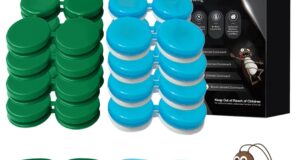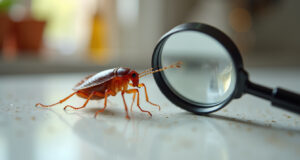German roach habitats cause worry for many. Homeowners and shop owners see these pests inside. They hide well until their numbers rise. We show where they live, why they go there, and how to act fast.
Understanding German Roach Habitats Indoors
German roaches (Blattella germanica) live in many rooms. They like warm spots. They need water and food. Kitchens, bathrooms, and food areas suit them.
The term “german roach habitats” means the places they choose. Knowing these spots helps you spot them faster.
Why Do German Roaches Prefer Indoor Habitats?
German roaches go where they get what they need:
- They need warm air. They stay best from 70 to 85°F (21-29°C).
- They drink from water leaks.
- They eat crumbs, grease, and bits of food.
- They hide in dark, tight spaces away from trouble.
Rooms like kitchens and bathrooms give them all they need. They rarely live outside in cool air. They stay inside most of the time.
Common German Roach Habitats Inside Your Home
Kitchens: The Top Spot for German Roaches
Kitchens give roaches food and warmth. They show up where food and water mix. They hide:
- In and under stoves, fridges, and dishwashers
- In cracks of cabinets
- Behind wall panels and sinks
- In pantries that hold food
At night, they come out to eat. In the day, they hide in tight dark spots.
Bathrooms: Another Wet Spot
Bathrooms hold much water. They are a good place for roaches. They hide:
- Under sinks and near pipes
- Behind toilets and along baseboards
- In drawers or small cabinets
- In cracks of tiles or near walls
Bathrooms offer less food, so roaches may move here from the kitchen.
Laundry Rooms and Basements
Laundry rooms give off heat and water. Basements, when damp and messy, are also homes for roaches. Look:
- Behind washers and dryers
- Close to water heaters
- In storage boxes and small corners
Commercial Settings
Restaurants and food stores see many roaches. Food and water here suit them. Poor cleaning helps them stay.
Detecting German Roach Habitats: Signs to Look For
To spot a roach home, look at:
- Roach droppings: Small black specks like coffee marks.
- Egg cases: Brown, small capsules by hide spots.
- Shed skins: Pale skins left when roaches shed.
- A strong musty smell: Large groups give a clear smell.
- Roaches seen at night: They hide from light and move when dark.
How to Manage and Prevent German Roach Habitats Indoors
Stop the roaches by breaking their home links. Here is how:
-
Remove Food Sources
- Clean up crumbs and spills fast.
- Keep food in tight, closed boxes.
- Empty trash often and use bins with lids.
-
Cut Down on Water
- Fix leaks from taps and pipes.
- Use a dry-air machine when needed.
- Keep air moving in kitchens and bathrooms.
-
Clear Clutter and Cover Gaps
- Throw out old papers or boxes.
- Seal cracks and gaps near pipes and walls.
- Keep storage neat and clear.
-
Set Traps and Baits
- Place roach baits near home spots.
- Set sticky traps in dark corners to watch roach moves.
-
Call a Pest Expert
- If many roaches appear, ask a helper for a full check and care.
Tips for Inspecting German Roach Habitats
- Check at night with a small light.
- Look in warm, low, and wet spots.
- Watch these areas often to catch a rise early.
Why Understanding German Roach Habitats Matters
Knowing where roaches live helps you stop them fast. If you do not break these home links, they will stay or come back. The Centers for Disease Control and Prevention say roaches may spread germs and harm breathing, especially in young ones. This can put health at risk.

Summary of Key German Roach Habitat Characteristics
| Habitat Location | Key Features | Common Roach Signs |
|---|---|---|
| Kitchen | Warmth, food bits, water | Droppings, egg cases, view |
| Bathroom | Water, near pipes | Shed skins, droppings |
| Laundry Rooms/Basements | Warmth, water, clutter | Smell, droppings, view |
| Commercial Food Areas | Food, water, warmth | Many roaches, seen at night |
Frequently Asked Questions About German Roach Habitats
Q1: Where are german roach habitats most often found indoors?
A1: German roaches live in kitchens and bathrooms. They hide in cabinets, under sinks, and behind appliances.
Q2: How can I find a german roach habitat in my home?
A2: Look for small black droppings, egg cases, pale shed skins, and a musty smell. Check dark, wet, and warm spots at night.
Q3: What steps help reduce german roach habitats indoors?
A3: Remove food and water spots, clear clutter, cover cracks, and set traps. If roaches still appear, call a pest expert.
Conclusion
German roach habitats inside homes make a hard task. Kitchens, bathrooms, laundry spaces, and food areas give roaches food, water, and warmth. Knowing these spots helps you plan to stop them. Keep your home neat, cut water leaks, and seal gaps. Should you see roaches, act fast with the right care and help from an expert. Small steps now keep your home free of roaches tomorrow.




